Quick Guide to Italy’s Regions: Central Italy
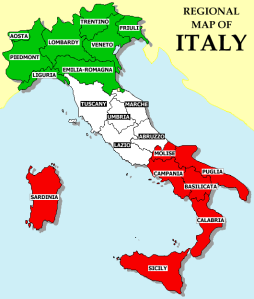 This is the first of a series of three posts about the Regions of Italy.
This is the first of a series of three posts about the Regions of Italy.
Because Italy is known for its rich history we sometimes forget it wasn’t unified until 1861. Before the country was unified it was made up of feudal city-states, each which functioned completely apart from one another and had their own distinctive character. Today there are officially 20 regions of Italy which became part of the unification, and remaining city-states.
-
Tuscany– With coast along the Tyrrhenian Sea, mountains, hill towns and fields there is something for everyone inthis region, and all of it is breathtaking. There are six locations in Tuscany on UNESCO’s list of World Heritage sites: Florence’s historic center, Siena’s historic center, Pisa’s cathedral square, San Gimignano’s historic center, Pienza’s historic center and the entire Val d’Orcia. Don’t forget to try the amazing chianti.
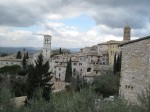 Umbria – Less touristy than Tuscany, Umbria’s rolling hills are just a beautiful. A visit to the church of St. Francis of Assisi in the town of Assisi is practically a right of passage. In fall this agricultural mecca becomes an absolute smorgasbord of fresh wine, olive oil, cheeses, truffles, and Umbria’s famous all pork sausages. Perugia sends delectable chocolate all around the world.
Umbria – Less touristy than Tuscany, Umbria’s rolling hills are just a beautiful. A visit to the church of St. Francis of Assisi in the town of Assisi is practically a right of passage. In fall this agricultural mecca becomes an absolute smorgasbord of fresh wine, olive oil, cheeses, truffles, and Umbria’s famous all pork sausages. Perugia sends delectable chocolate all around the world.- Le Marche – Especially popular with the British, this region boasts clear shoreline on the Adriatic, mountains, hill towns and fields reminiscent of Tuscany. Le Marche’s most well known city is probably UNESCO World Heritage Site Urbino. Capitol city and port town Anconia is busy in thee high season as it serves as berth for several cruise lines. Pesaro, San Benedetto del Tronto, and Fano are popular beach towns for Italians and tourists alike.
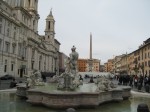 Lazio – This region is home to Rome, the capitol of Italy. While Rome is definitely wonderful and exciting, there is much more to see in Lazio outside the capitol’s gates. There are three UNESCO World Heritage Sites in Lazio besides Rome which are the Etruscan necropolises of Tarquinia and Cerveteri, the Villa Adriana at Tivoli, and the Villa d’Este at Tivoli. Tivoli is a great day trip from Rome with its lavish gardens and villas. Ostia Antica, an excavated Roman ruin, is also only a short train ride from central Rome. Further north is Viterbo, once a retreat for Popes, as well as the sites of Etruscan tombs at Tarquinia and Cerveteri. The long coastline of Lazio is dotted with beach towns which are a huge draw in the summer.
Lazio – This region is home to Rome, the capitol of Italy. While Rome is definitely wonderful and exciting, there is much more to see in Lazio outside the capitol’s gates. There are three UNESCO World Heritage Sites in Lazio besides Rome which are the Etruscan necropolises of Tarquinia and Cerveteri, the Villa Adriana at Tivoli, and the Villa d’Este at Tivoli. Tivoli is a great day trip from Rome with its lavish gardens and villas. Ostia Antica, an excavated Roman ruin, is also only a short train ride from central Rome. Further north is Viterbo, once a retreat for Popes, as well as the sites of Etruscan tombs at Tarquinia and Cerveteri. The long coastline of Lazio is dotted with beach towns which are a huge draw in the summer.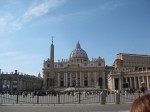 Vatican City (city-state) – Completely enclosd within the city of Rome, Vatican City is the smallest independent state in the world. The entire enclave is an UNESCO World Heritage Site and revolves completely around the Catholic church. The Vatican Gardens make up more than half of the land included in Vatican City, only a portion of which are open to visitors. St. Peter’s Basilica and Piazza are the city’s centerpiece.
Vatican City (city-state) – Completely enclosd within the city of Rome, Vatican City is the smallest independent state in the world. The entire enclave is an UNESCO World Heritage Site and revolves completely around the Catholic church. The Vatican Gardens make up more than half of the land included in Vatican City, only a portion of which are open to visitors. St. Peter’s Basilica and Piazza are the city’s centerpiece.- Abruzzo – Because Abruzzo has no major cities it hadn’t received much press until late, when an earthquake struck the capitol city of L’Aquila the spring of 2009. Despite this somber introduction, Abruzzo is a wonderful region of miles of Adriatic coastline and mountains unspoiled by crowds of tourists. One-third of the region is made up of national parks, and has some of the country’s best-preserved medieval and Renaissance hilltowns. The George Clooney film “The American” was filmed here.
Posted on July 7, 2011, in Uncategorized and tagged Abruzzo, city-states, italy, Lazio, Le Marche, regions, Tuscany, Umbria. Bookmark the permalink. Leave a comment.
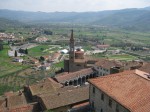
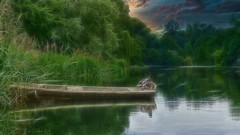
Leave a comment
Comments 0